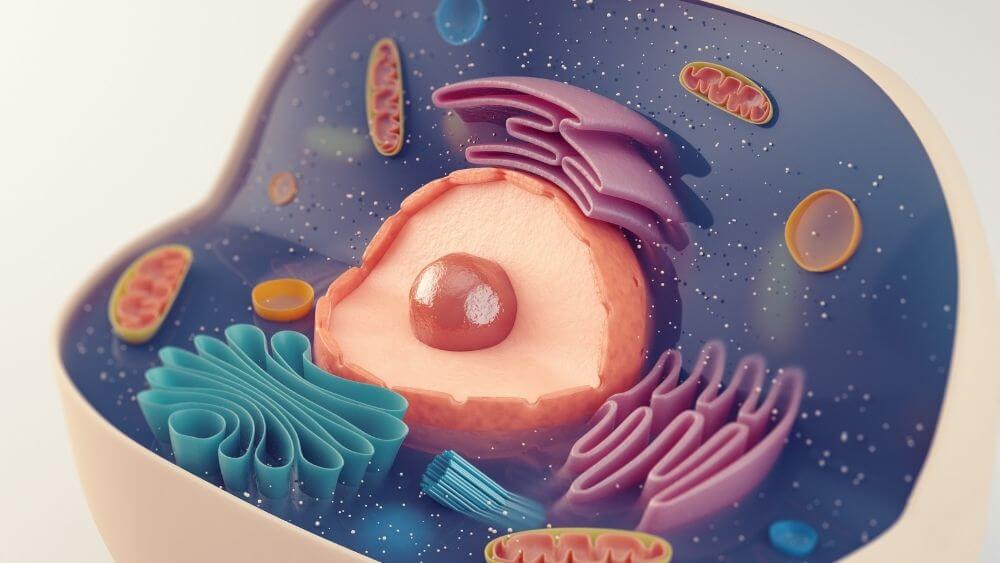Cell Structure and Functions

Contents
What is a cell?
A cell can be defined as the building block of living organisms. It is the basic structural unit of a living organism.
We can compare a cell to a brick. Individual bricks are used to make up a building. Although buildings look different from each other all of them are still made up of more or less the same bricks. Similarly, cells assemble to form the body of a living organism and all living organisms look different from each but all are ultimately made up of cells.
Variety Of Cells In Different Organisms:
The number, type and shape of cells vary considerably in different organisms. A cell is usually visualized by staining the cell with a suitable dye or stain and then observing it under a microscope.
Number of Cells:
Living organisms can be broadly classified into two types –
1. Unicellular Organisms:
- Unicellular organisms are made up of a single cell.
- These single celled organisms carry out the same functions as a complex multicellular organism.
- Examples include amoeba and paramecium. Amoeba captures and digests food, excretes wastes, grows and reproduces i.e., it carries out all the functions observed in multicellular organisms.
- In fact, the fertilized egg itself is a single cell. It undergoes multiple divisions to give rise to the embryo which eventually grows and develops into a complex multicellular organism.
2. Multicellular Organisms:
- Multicellular organisms are composed of more than one cell.
- A group of specialized cells function together to form tissues and tissues together comprise an organ.
- Thus, the distinct function performed by an organ depends on the cellular composition.
- Examples of multicellular organisms include human, cats, plants, fungi, etc.
Shape of Cells:
- Cell structure is determined by the outer covering of cells known as the cell membrane.
- Plant cells and bacterial cells have an additional outer layer known as the cell wall although the composition is very different.
- The cell membrane (and cell wall) provide rigidity and shape to a cell.
- The function of a cell also determines the shape of a cell.
- In general, cells are round, spherical or elongated. Some cells are spindle shaped as they are long and pointed at both ends.
- Some cells are branched for example neurons or nerve cells.
- There are also cells that do not have any defined shape. For example amoeba is described as irregularly shaped. Amoeba possess projections called pseudopodia for locomotion; these pseudopodia appear and disappear and therefore the unicellular organism has no defined shape.
- White blood cells (WBCs) in human beings also can change their shape like amoeba.
Size of Cells:
- Cells vary considerably in terms of size.
- Cells can range from only a few micrometre to several centimetre. But in general, most cells are microscopic in size and cannot be observed with the unaided eye.
- The smallest cells are bacterial cells ranging from 0.1 to 0.5 micrometre in size.
- The largest cell is an ostrich egg measuring 170 * 130mm.
- The size of a cell does not correlate to the size of an organism. For example the nerve cells in a rat and in an elephant are of the same size and they perform the same function in both organisms.
Cells, Tissue and Organs:
Organs are responsible for carrying out specific functions in a body. For example, the various organs of the digestive system are responsible for digestion, assimilation and absorption.
- An organ is made up of smaller parts or components known as tissues.
- A tissue in turn is made of a group of cells that exhibit a specific function.
- The various organs of the body work together to help the body function.
- Therefore, the cells are the building blocks of the body.
Parts of A Cell:
A cell mainly consists of three main components -cell membrane, cytoplasm and nucleus.
Cell Membrane –
- The cell membrane, also known as the plasma membrane, is the outer layer of the cell that encloses the cytoplasm and the nucleus.
- The cell membrane acts as a barrier, separating the cell from the other cells (in case of a multicellular organism) as well as the surrounding medium.
- The cell membrane is porous and allows the passage of nutrients and other essential materials into and out of the cell.
- In a plant cell, there is an additional protective layer surrounding the cell membrane known as the cell wall.
- Plants are exposed to variations in temperature, high wind speed, atmospheric moisture, etc. Since plants are unable to move, their cells require this additional protection.
- Cell walls can be observed in the leaf peel of Tradescantia, Elodea or Rhoeo. Slides can be prepared from onion peels and observed under the microscope very easily.
Cytoplasm –
- It is the jelly like substance enclosed within the cell membrane.
- The nucleus is suspended in the cytoplasm along with distinct components called organelles.
- There are a variety of organelles which are responsible for specific functions such as mitochondria, golgi apparatus, endoplasmic reticulum, ribosomes, etc.
Nucleus –
- The nucleus is essentially the control centre of the cell and is also responsible for the inheritance of characters. It can be observed under a powerful microscope after staining.
- It is also surrounded by a porous membrane known as the nuclear membrane.
- The nuclear membrane allows the exchange of materials between the nucleus and the cytoplasm.
- The nucleus contains a spherical body called the nucleolus.
- The nucleus also consists of thread-like structures called chromosomes; chromosomes in turn contain genes. They are responsible for the inheritance of characters from parents.
Chromosomes can only be seen when the cell divides.
The nucleus and the cytoplasm together form the entire content of the cell and is known as the protoplast.
Prokaryotic and Eukaryotic Cells:
There are cells in which the nuclear material is not surrounded by a nuclear membrane and such cells cells or organisms are called prokaryotes. Examples include bacteria and blue green algae. Cells or organisms which have a well defined nucleus surrounded by a nuclear membrane are known as eukaryotes. Examples include all organisms except bacteria and blue green algae.
Certain cells contain a number of blank-looking structures known as vacuoles. A cell may contain a single, large vacuole as observed in onion cells or there may be multiple, small vacuoles in a single cell. Plant cells usually have large vacuoles whereas animal cells have much smaller vacuoles.
Several small coloured structures can be observed in the cells of the Tradescantia leaf. These are known as plastids and are scattered in the cytoplasm of leaf cells. They may be of different colours depending on the pigment present in them. Plastids containing chlorophyll, the green pigment required for photosynthesis, are called chloroplasts.
As we can clearly understand, plant cells and animal cells have multiple similarities as well as differences. Make a list of them by comparing on the basis of cellular components such as cell membrane, cell wall, cytoplasm, nucleus, nuclear membrane, vacuole and plastids.
Summary:
- What is a cell?
- Variety of cells
- Unicellular and Multicellular Organisms
- Cell Size
- Cell Shape
- Cells, Tissues and Organs
- Parts of a cell
- Prokaryotic and Eukaryotic Cells
- Vacuole
- Plastids
- Comparison Between Plant and Animal Cells






Responses